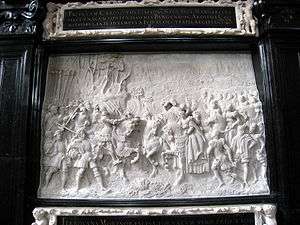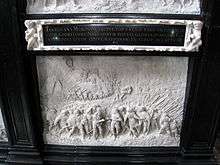Alexander Colyn

Alexander Colyn (also spelt Colin or Colins; 1527/29 – 17 August 1612) was a Flemish sculptor.
Biography
Colyn was born in Mechelen, Belgium. In 1563 he went, at the invitation of the emperor Ferdinand I, to Innsbruck, to work on the magnificent monument which was being erected to Maximilian I in the nave of the Franciscan church. Of the twenty-four marble altirilievi (high reliefs), representing the emperors principal acts and victories, which adorn the sides of this tomb, twenty were executed by Colyn, apparently in three years. The work displays a remarkable combination of liveliness and spirit with extreme care and finish, its delicacy rivaling that of a fine cameo. Bertel Thorvaldsen is said to have pronounced it the finest work of its kind. Colyn, who was sculptor in ordinary both to the emperor and to his son, the archduke Ferdinand of Tirol, did a great deal of work for his patrons at Innsbruck and in its neighborhood; particular mention may be made of the sepulchers of the archduke and his first wife, Philippine Welser, both in the same church as the Maximilian monument, and of Bishop Jean Nas. His wife Maria de Vleeschouwer's tomb is by his hand and dated 1594.[1] His own tomb in the cemetery at Innsbruck bears a fine bas-relief executed by one of his sons.
In Innsbruck he also made (1566-1590) so called Royal Mausoleum for St. Vitus Cathedral at Prague Castle. It is a marble tomb, where are depicted and buried members of the Habsburg Monarchy: emperor Ferdinand I with his wife Anna of Bohemia and Hungary and their son emperor Maximilian II.
He is credited with bringing the artistic style of European courts to Germany, where he managed (1558-59) the sculpting of the Ottheinrichsbau (German, Ottheinrich palace or simply building) in Heidelberg, Baden-Württemberg. He contributed to the tombs of Ferdinand II, which he designed, and of Maximilian I, where he sculpted a number of marble reliefs.
Students
Colleagues and students in his workshop in Innsbruck were his son Andreas Colyn, also known as Andreas de Clievere, Hans Conrad, Dominik Farent, and Franz Perwon.[1]
Works
-

Alexander Colyn, cenotaph of Maximilian I, marble relief based on wood carvings by Albrecht Dürer
-

Alexander Colyn, cenotaph of Maximilian I, marble relief based on wood carvings by Albrecht Dürer
-

Alexander Colyn, cenotaph of Maximilian I, marble relief based on wood carvings by Albrecht Dürer
-

Alexander Colyn, cenotaph of Maximilian I, marble relief based on wood carvings by Albrecht Dürer
-

Alexander Colyn, cenotaph of Maximilian I, marble relief based on wood carvings by Albrecht Dürer
-

Alexander Colyn, cenotaph of Maximilian I, marble relief based on wood carvings by Albrecht Dürer
-
Alexander Colyn, Royal Mausoleum at Prague Castle, tomb of Ferdinand I, Anna and Maximilian II.
See also
References
- 1 2 Alexander Colyn in the RKD
Sources
 This article incorporates text from a publication now in the public domain: Chisholm, Hugh, ed. (1911). "article name needed". Encyclopædia Britannica (11th ed.). Cambridge University Press.
This article incorporates text from a publication now in the public domain: Chisholm, Hugh, ed. (1911). "article name needed". Encyclopædia Britannica (11th ed.). Cambridge University Press.
Further reading
- Schwöbel C. Liber amicorum Raphaël de Smedt. 2. Artium historia: Action and Revelation. Peeters Publishers. ISBN 90-429-1051-8.
External links
| Wikimedia Commons has media related to Alexander Colin. |